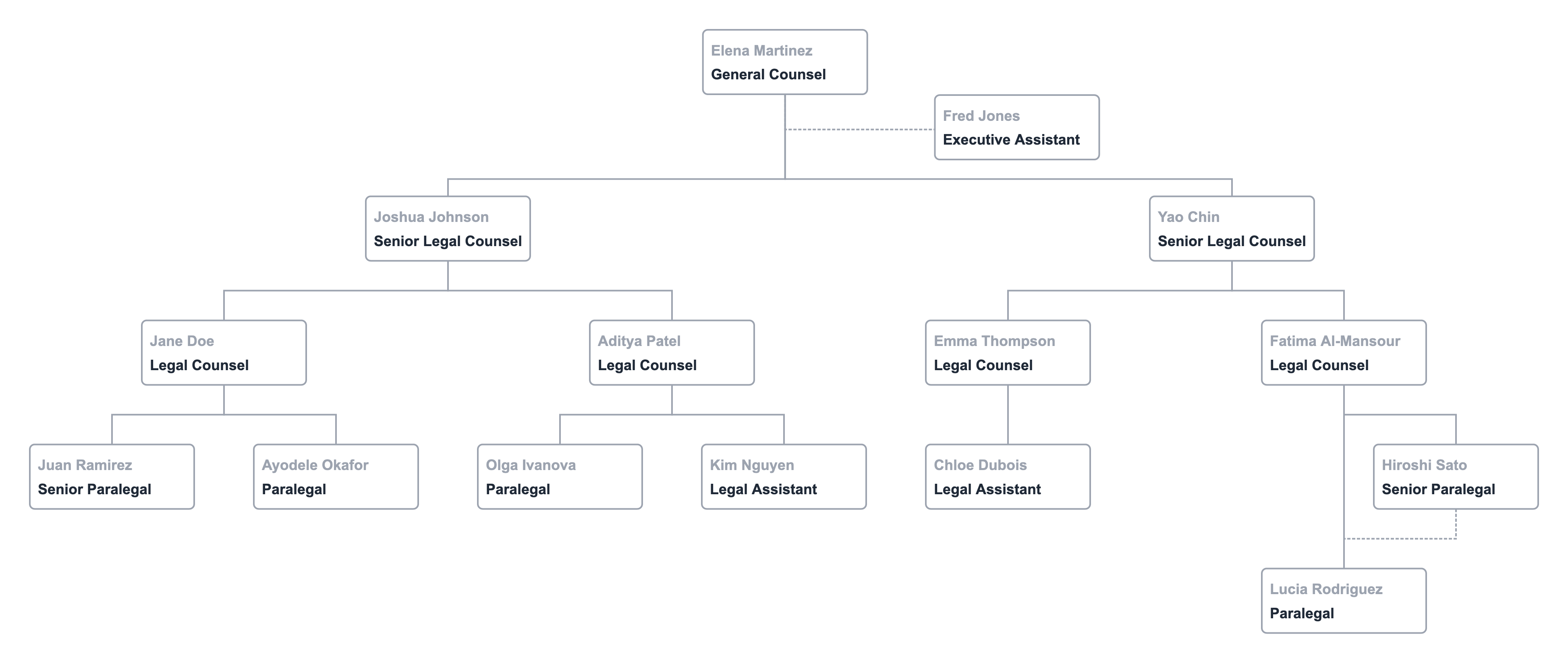How to Structure a Legal Department

Legal departments are essential components of successful organizations, providing legal guidance, risk mitigation, and contract negotiation services. As organizations grow, structuring a legal department to maximize efficiency and productivity becomes crucial. The article defines essential issues in legal department using this organization chart as an example.
Determine the Roles and Responsibilities
First, define the various roles and responsibilities required to support the legal needs of your organization. Common positions include:
- General Counsel: This is the head of the legal department, responsible for overall legal strategy, department management, and serving as the primary legal advisor to the organization's leadership.
- Senior Legal Counsel: These experienced attorneys assist the General Counsel in managing legal matters and supervising other team members.
- Legal Counsel: These are the attorneys responsible for handling day-to-day legal tasks, such as contract review, compliance, and dispute resolution.
- Paralegals: Paralegals provide legal support, including research, document preparation, and case management.
- Legal Assistants: These professionals provide administrative support to attorneys and paralegals, including scheduling, correspondence, and document management.
Establish Reporting Relationships
Next, create a clear hierarchy within the legal department that outlines reporting relationships and lines of authority. This structure ensures accountability, effective communication, and smooth decision-making processes. Consider the following example list of employees and reporting relationships:
| Manager | Employee | Job Title |
|---|---|---|
| Elena Martinez | Joshua Johnson | Senior Legal Counsel |
| Elena Martinez | Yao Chin | Senior Legal Counsel |
| CEO | Elena Martinez | General Counsel |
| Joshua Johnson | Jane Doe | Legal Counsel |
| Joshua Johnson | Aditya Patel | Legal Counsel |
| Yao Chin | Fatima Al-Mansour | Legal Counsel |
| Yao Chin | Emma Thompson | Legal Counsel |
| Jane Doe | Juan Ramirez | Senior Paralegal |
| Jane Doe | Ayodele Okafor | Paralegal |
| Aditya Patel | Olga Ivanova | Paralegal |
| Aditya Patel | Kim Nguyen | Legal Assistant |
| Fatima Al-Mansour | Hiroshi Sato | Senior Paralegal |
| Fatima Al-Mansour | Lucia Rodriguez | Paralegal |
| Emma Thompson | Chloe Dubois | Legal Assistant |
| Emma Thompson | Mohammed El-Amin | Paralegal |
| Joshua Johnson | Kim Nguyen | Legal Assistant |
| Yao Chin | Chloe Dubois | Legal Assistant |
Foster Collaboration and Communication
Encourage collaboration and communication between team members by implementing regular meetings, fostering a culture of open dialogue, and using collaboration tools. This approach will ensure that the legal team works cohesively and effectively addresses the organization's legal needs.
Continuously Evaluate and Adapt
Regularly assess the performance and structure of your legal department to identify areas for improvement. This process may include soliciting feedback from team members, reviewing key performance indicators, and analyzing the department's impact on the organization. Be prepared to make adjustments to the structure and roles as needed to ensure optimal performance.
In conclusion, structuring a legal department involves defining roles and responsibilities, establishing clear reporting relationships, fostering collaboration and communication, and continuously evaluating and adapting to changing needs. By following these guidelines, you can create a well-structured legal department that effectively supports your organization's legal needs.
Learn more about management organization charts in Organization Charts: the Complete Guide.

